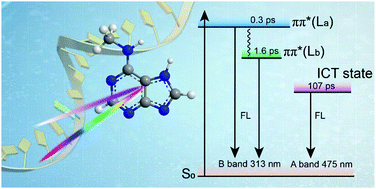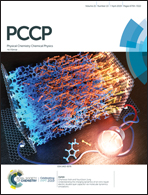Direct observation of an intramolecular charge transfer state in epigenetic nucleobase N6-methyladenine†
Abstract
N6-Methyladenine (6MeAde), the most abundant internal modification in mRNA, has proved to be an important epigenetic biomarker for gene regulation just like 5-methylcytosine in DNA. Recently, a unique UV-induced response of 6MeAde was reported, which makes it instructive and intriguing to reveal the excited state relaxation mechanism in this methylated adenine and its derivatives. In this work, we investigated 6MeAde and its ribose species N6-methyladenosine (6MeAdo) by using femtosecond time-resolved fluorescence up-conversion (FUC) and broadband transient absorption (TA) spectroscopy. Both 6MeAde and 6MeAdo exhibit a hundreds of femtoseconds lifetime, which originates from the efficient depletion of the ππ* (La) state. A several picoseconds lifetime is also observed and it should be attributed to the ππ* (Lb) state. Surprisingly, dual peak fluorescence emission is observed in 6MeAde and the long wavelength emission is ascribed to an intramolecular charge transfer (ICT) state. The lifetime of this ICT state is determined to be 107 ps. The kinetic isotope effect shows that the ICT state is closely associated with the solute–solvent H-bonding in aqueous solution. In 6MeAdo, the ICT state is apparently quenched and adenine-like excited state dynamics suggests that DNA/RNA containing such modification could still possess excellent photostability under UV irradiation. Our results contain an important insight for understanding excited state properties in epigenetic modified DNA/RNA.

- This article is part of the themed collection: 2019 PCCP HOT Articles


 Please wait while we load your content...
Please wait while we load your content...